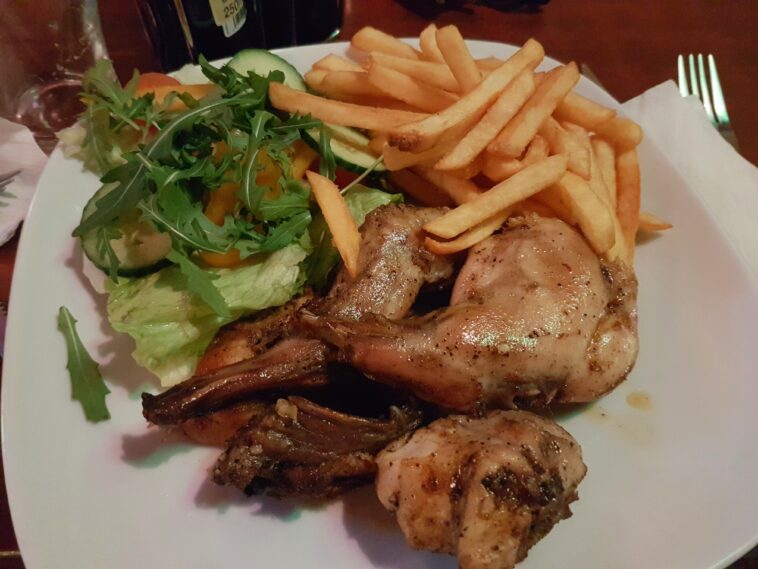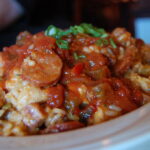- Introduction
- Introduce Kaninchen mit Wacholder.
- Highlight its place in traditional European cuisine.
- Historical and Cultural Background
- Explore the origins of cooking rabbit in European culinary history.
- Discuss the use of juniper in cooking and its cultural significance.
- Ingredients and Their Roles
- List all the ingredients with a focus on rabbit and juniper berries.
- Explain the importance and flavor profile of each ingredient.
- Detailed Step-by-Step Cooking Guide
- Provide a comprehensive guide for preparing and cooking the dish.
- Include tips for handling and cooking rabbit meat.
- Nutritional Information
- Discuss the nutritional content of rabbit meat and other ingredients.
- Offer suggestions for making the dish healthier or accommodating dietary restrictions.
- Serving and Pairing Suggestions
- Recommend side dishes and beverages that complement the flavors.
- Presentation and garnishing tips.
- Variations of the Recipe
- Explore regional variations and modern adaptations of the recipe.
- Include alternatives for common dietary preferences and restrictions.
- Storage and Reheating Instructions
- Best practices for storing and reheating leftovers.
- Common Mistakes and Solutions
- Identify potential pitfalls in the preparation process and offer solutions.
- FAQ Section
- Address frequently asked questions about the recipe.
- Conclusion
- Summarize the appeal of Kaninchen mit Wacholder.
- Encourage readers to embrace the traditional cooking method.
Table of Contents
TogglePartial Article Write-Up
Introduction
Kaninchen mit Wacholder, a classic dish in European cuisine, showcases the delicate and flavorful rabbit meat infused with the distinct taste of juniper berries. This dish, rooted in traditional cooking techniques, offers a unique taste experience that reflects the rich culinary heritage of Europe.
Historical and Cultural Background
Rabbit has been a staple in European diets for centuries, valued for its lean, nutritious meat. The addition of juniper berries, with their piney and slightly fruity flavor, is a testament to the European tradition of using local herbs and spices to enhance the natural flavors of meat. This dish is often associated with rustic, countryside cooking and has been passed down through generations.
Ingredients and Their Roles
The primary ingredient in Kaninchen mit Wacholder is rabbit, known for its tender and slightly gamey meat. Juniper berries are crucial for their unique flavor, which pairs excellently with the mildness of rabbit. Other ingredients typically include root vegetables, such as carrots and onions, and herbs like thyme and rosemary, which contribute to the depth and complexity of the dish’s flavor profile.
Detailed Step-by-Step Cooking Guide
Preparing Kaninchen mit Wacholder involves several key steps, starting with the marination of the rabbit in a mixture of juniper berries, herbs, and wine. The marinated meat is then slowly cooked with the vegetables and additional seasonings until tender. The article would provide detailed instructions on each step, ensuring a perfectly cooked dish that highlights the flavors of all the ingredients.
Nutritional Information
Rabbit meat is known for being lean and high in protein, making it a healthier alternative to some other types of meat. Juniper berries also offer health benefits, including anti-inflammatory properties. The article would discuss the nutritional benefits of the main ingredients and suggest ways to make the dish lighter or more nutritious, such as incorporating more vegetables or using less oil.
Serving and Pairing Suggestions
Kaninchen mit Wacholder is traditionally served with simple side dishes that complement its rich flavors, such as boiled or roasted potatoes and sautéed greens. For wine pairings, a medium-bodied red wine that can stand up to the robust flavors of the dish would be recommended.
Variations of the Recipe
While the traditional recipe for Kaninchen mit Wacholder is cherished, there are variations and modern twists that can be explored. These might include using different herbs or spices, incorporating other vegetables, or even adapting the recipe for different types of meat for those who do not consume rabbit.
Storage and Reheating Instructions
Proper storage and reheating are important for maintaining the quality and safety of the leftovers. The article would offer guidelines on how to store the dish in the refrigerator or freezer and the best methods to reheat it without drying out the meat.
Common Mistakes and Solutions
Cooking rabbit meat can be challenging for those unfamiliar with it. Common mistakes, such as overcooking the meat or not balancing the flavors properly, would be addressed,


